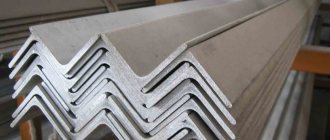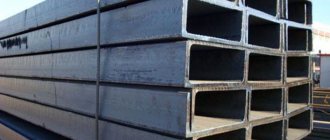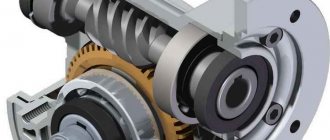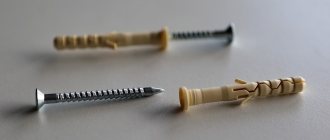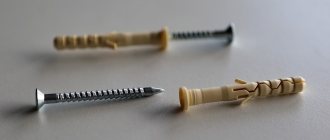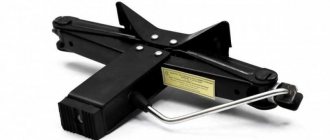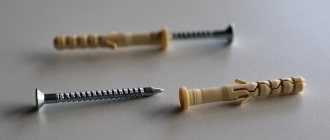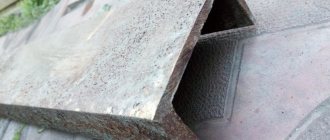The principle of operation of the frame anchor is quite simple: after installing it, a screw is screwed into the mounting hole. During this process, the cone-shaped nut located at its end gradually rises up the threads. As it moves, it puts pressure on the lower edge of the spacer sleeve, causing its slots to expand and form a kind of petals. It is they, being embedded in the base material, that ensure reliable fixation of all hardware in the installation base.
Among the design features of the frame dowel, it is worth highlighting the design of its cap. Firstly, it is designed for a Phillips screwdriver. The slots are of this shape:
- provide significantly more torque;
- do not allow the tool to easily slip out of the head, as often happens when working with a single-slotted head when the screw is tightened with force,
Secondly, the cone-shaped shape of the cap ensures that it is buried “sunk” into the hole. This should be taken into account when drilling the mounting socket.
Another design feature of the frame anchor is the number of expansion zones. According to this criterion, such fasteners come in several types. In particular:
- single-expansion dowel. Found the most widespread use. Reliably fixed in solid non-slotted brick, non-cellular concrete, that is, in a solid and fairly heavy material;
- frame anchors with 2 expansion zones. Of course, they can be installed in the same materials. However, the real scope of application of these fasteners is wider. This is also aerated concrete, one of the varieties of porous building materials - cellular/lightweight concrete, as well as brick with internal voids. The length of the working part of such a dowel is longer than that of the product of the previous version. In addition, it forms 2 wedging areas. This design solution ensures reliable fastening due to the fact that if one of the sections becomes wedged into an existing cavity in the material, the second will still penetrate into the mounting base.
Dowel concept
To be fair, the dowel is not the fastening itself, but that part of it that is inserted into the base and provides the very possibility of fastening. Its predecessor was an ordinary wooden plug - a chopik, which was driven into the walls so that it became possible to drive a nail into the base.
The dowel still plays the same role today. But, it is true, modern models offer the possibility of mounting on a wide variety of materials: heavy concrete and porous, hollow brick and dense natural stone, gypsum, drywall and loose slag concrete. The design of the product provides such wide possibilities.
A dowel is a sleeve or sleeve. The dowel itself does not form a fastening, but is firmly fixed in the wall material. An object or material is secured by screwing or driving a nail, screw or screw into the sleeve. At the same time, the sleeve changes shape - it expands, twists, folds, that is, it forms a very reliable adhesion to the base.
General information about frame dowels
At its core, this hardware has a rod, which in principle resembles an ordinary screw or self-tapping screw. Its task is to tighten and fix two or more structural components. But the main difference is the presence of an auxiliary element that holds the anchor. A frame dowel usually does not require the use of special industrial tools for installation. Most often, even specialists limit themselves to a basic set of tools that allow them to form a hole of suitable size.
Specifications
One of the main parameters of any material on which physical activity is expected to be applied is its technical characteristics. For dowels, the main indicators are as follows:
the length of standard products ranges from 40 to 140 mm, in increments of 20 mm;
metal nail diameter - from 5 to 7 mm;
The diameter of the hole that should be made in the wall surface is from 6 to 10 mm. The designation of the fastener model is made up of two indicators: hole diameter and length, and looks like 6x40, 8x100, 10x100, etc.
The maximum thickness of materials that the dowel can attach is from 10 to 100 mm. This indicator is important to take into account when preparing materials for thermal insulation, since incorrectly selected fasteners may simply not reach the wall, or the location of its opening will not be deep enough.
Fasteners are produced from high-quality steel grades St 50, 60, 70, galvanized to prevent corrosion. The opening part is made from various polymer materials: polyethylene, polypropylene, polyamide. The first two materials have low resistance to negative temperatures, while polyamide is well suited for external work, for example, for thermal insulation and waterproofing of a house, installation of sheathing under siding or a block house, etc.
How to choose a frame dowel?
Unlike standard screws and standard dowels, this fastener requires a special calculation to match a specific standard size to the installation tasks. Each parameter matters. For example, in harsh operating conditions, a thick protective coating must be provided on the outside. If you plan to install while maintaining a smooth surface, then you should choose a metal frame dowel with a flat head. And, of course, it is mandatory to select an element in terms of dimensional parameters - the characteristics of length and width that are suitable for the format of the target building material are assessed.
Types of dowels
In stores you can find a large selection of different dowels. But each of them is created for one purpose or another.
Universal polypropyleneThe simplest, but suitable for most types of work, including stone, concrete and brick. When screwing in the self-tapping screw, the dowel material is wound onto the metal, thereby securing the structure |
Universal expansion dowelIt is also made of polypropylene, but has special spacers, due to which it is held inside the hole |
Dowel nailAllows you to quickly and efficiently fasten windows, sheathing, skirting boards, beams, cable ducts, metal profiles, as well as plywood into concrete, stone or brick surfaces. Made of nylon or polypropylene, nail made of steel |
Drywall dowelDesigned for mounting various elements into sheets of plasterboard or gypsum fiber, as well as porous concrete. This fastener is made of plastic or metal. The second option (also called a “molly” dowel) does not require pre-drilling holes, since the tip of the metal dowel looks like a feather drill |
Nylon dowelAs the name suggests, it is made of nylon. It can be used in almost any situation and on any surface. Due to the presence of fastening antennae, the nylon dowel is securely held in the wall. Self-tapping screws for such a dowel usually have a diameter of 0.02-0.16 cm |
Butterfly dowelDesigned to perform serious installation work. This fastener can withstand enormous loads even if there are hollow walls. Made from metal |
Adjustment dowelWith its help, the sheathing is attached for future cladding. The main feature of this type of fastener is the ability to regulate (adjust) the position of the elements relative to the base to which they are attached |
Dowel-umbrellaA special type of dowels designed for installing thermal insulation made of mineral wool and polystyrene. The appearance of the fastener fully explains its name: a wide round cap, the main purpose of which is to hold the insulation against the wall. “Umbrellas” are made of both plastic and metal. But “umbrellas” are also called another type of dowels designed for working with drywall, mostly with hanging structures. This metal “umbrella” Molly is a nail with metal shoulders that are securely attached to a hollow structure, evenly distributing the load. Using this type of dowels you can easily hang any chandelier in a suspended ceiling |
Dowel clampIt looks like a loop made of plastic (nylon), with “antennae” along the edges, due to which the fastener will be held. Clamps are designed for mounting electrical wiring to the wall. Working with this type of dowel is very simple: first, a hole of the required diameter and depth is drilled, and then the required wire is simply pressed with a clamp, the edges of which are inserted into the previously drilled hole. They can also be used to attach small-diameter corrugated pipes |
Frame dowelIt is made of metal, since its area of application is very specific. Designed for installation of window and door frames. A metal frame dowel is also suitable for fastening the sheathing through a layer of plaster and thermal insulation. |
Main advantages
The dowel element has a range of advantages:
- does not scroll in weakened channels;
- holds well in porous building materials;
Metal dowel for sheet materials W-GS, type Z/L - withstands significant forces without changing the initial position;
- does not allow the fastening element to fall out;
- does not become loose under alternating loads;
- easily enters building materials upon impact.
Along with increased performance characteristics, dowel fasteners are reliable and durable.
Installation recommendations
First of all, before attaching the dowel, the working surface is cleaned. Next, you need to choose the method in which the hole will be implemented. Typically, electric screwdrivers with suitable attachments are used for such needs. In this part, you should evaluate not the diameter of a particular screw, but the size of its spacer nozzle, which will hold the rod in the niche being created. Also, depending on the operational requirements, it may be necessary to hide the cap. To do this, a chamfer is additionally formed, expanding the outlet part of the hole to integrate the head. By the way, if you are installing a frame dowel for hollow materials, then you can get by with a hand tool, which will delicately and with greater precision allow you to prepare the hole for the hardware. Next, the spacer is installed, followed by tightening the fastener.
What material is the dowel plug made of?
Most fasteners are made from plastic. This is due to the low cost, availability, increased performance characteristics of the material, as well as the lack of the need to apply significant effort when screwing fasteners.
Various types of polymer materials are used for the manufacture of plastic retainers.:
- polyethylene. Easily deformable while maintaining integrity. It is lightweight and resistant to corrosion. Can be used when temperatures drop to 40 degrees below zero. Disadvantage: gradual loss of performance properties and cracking;
- polypropylene. It is used mainly indoors, as it is susceptible to negative temperatures. Advantages: increased hardness, wear resistance, and the ability to operate at high temperatures. The weak side is the appearance of cracks during long-term operation under temperature changes;
- polyamide. The material is also known as nylon. It is little subject to wear and is not afraid of mechanical stress. The nylon fastener is the most durable and reliable among other plastic fasteners.
Dowel for thermal insulation with a metal nail and thermal plug Strezzar Standard ST-M10x140 - 1
Along with plastic clamps, metal products are used :
- of stainless steel;
- galvanizing;
- alloys based on brass or bronze.
Despite the increased strength characteristics and rigidity of metal fasteners, they are inferior to plastic in their ability to deform while maintaining integrity. At the same time, the metal is able to withstand increased loads. Protective coatings significantly increase the service life of metal dowel elements.
Material of manufacture
The main screw is most often made of steel. This is a reliable, rigid and at the same time durable material, optimally suited to the requirements of fastening operations. Its only weak point is its susceptibility to corrosive processes, but technologists, as already noted, provide galvanized and other galvanic coatings that protect hardware from destruction. It is also worth paying attention to the material of the spacer tip that is supplied with the frame dowel. A nylon element can be considered as the optimal solution, although there are also quite hard plastic analogues. Moreover, dowel bases are often made from synthetic plastic materials. Such hardware in its design is quite consistent with the group of frame models, with the exception of the material of manufacture. Such products are used for highly specialized purposes, for example, in the construction of thermal insulation panels that do not require rigid and high-strength fixation.
Dowel installation procedure
The procedure for installing a dowel into a brick wall consists of the following steps.
- The first thing to do is to carefully drill a mounting hole for mounting the fastener. This can be done using an electric drill or hammer drill with only drilling mode (no impact) turned on. It is important that the diameter of the drill used to perform this procedure exactly matches the diameter of the dowel itself.
- After drilling, the hole must be thoroughly cleaned of construction dust and pieces of material that have crumbled into its internal cavity. You can check how thoroughly you have cleaned the hole using the dowel itself: it should fit in without difficulty or obstacles.
- When the hole is thoroughly cleaned, you can begin work with dry tile adhesive, which must be diluted with water in the proportion specified by the manufacturer. After the adhesive mass is ready for use, it is necessary to fill the hole drilled for the dowel. You can use a rubber spatula for this, and you can push the adhesive mass into the depth of the hole using the dowel itself or an ordinary pencil. When the hole is completely filled with adhesive, you can insert a dowel into it, which should go into it all the way. After this, you need to let the adhesive composition completely harden, which is quite enough for 24 hours.
- After the tile adhesive has completely hardened, you can screw a threaded element (pin or screw) into the dowel. In this case, be sure to pay attention to the fact that screwing occurs with some force. This means that your dowel is securely fixed into the brickwork. Fasteners obtained using this simple technology are highly reliable and can withstand even significant weight loads.
You can also use this method if you need to install fasteners in a porous material (the use of concrete dowels for such structures is also prohibited). Such materials, in particular, can be gas or foam concrete, porous brick, etc. Taking into account their high popularity in the modern construction market, the choice of fasteners that could ensure reliable fastening of objects fixed on such structures is a rather serious problem.
What is a dowel?
A metal dowel-nail is a metal base with a plastic tip at the end. This ensures tight fixation of parts in the cavity of concrete and iron material. This product is most often used as a connecting link between the supporting structure and the surface on which the building structure will be located.
The metal dowel for concrete is made of heavy-duty metal steel. It can withstand daily challenges and heavy loads. There are screw threads along the entire perimeter of the iron product. Thanks to them, the dowel is firmly attached to the wall cavity.
To ensure that the fastener does not deform under the weight of the load, plastic stop wings were developed. They open when the dowel is screwed into the concrete base.
The metal dowel for thermal insulation is a long iron body with a mushroom-shaped bolt. For tight fixation, special glue is used. A small amount of adhesive is placed into the prepared hole.
Next, a plastic tip is placed here. It will provide high-quality insulation between the concrete base and the building material. Now we begin to fix the metal dowel. To do this, use a screwdriver.
Features of using dowels
When choosing a dowel, it is not enough to focus on its shape; it is also important to know what size (length, diameter) to choose. For each working surface it is necessary to select its own fasteners. The “six” dowel (6*40) is suitable for installing profile structures in cinder block houses. By choosing a different size, it will not be possible to make repairs, since all the fasteners will simply fall out of the drilled holes.
For panel houses (as well as those where there are no voids in the walls), the best option for dowels is 6*60 or 6*80. With them, everything will be securely fastened, nothing will fall through or fall out even on the ceiling.
When choosing the length of the dowel, it is worth remembering the load that the fastener will be subjected to in the future during operation. The shorter the dowel and self-tapping screw, the less load it will withstand. The diameter is also important. For ordinary housework (hanging a cabinet, mirror or wall unit), dowels with a diameter of 8-10 mm are sufficient. The only difference is the depth of the hole being drilled, since the load on the dowel is different.
For a cabinet, 3-5 cm is enough, and for a wall unit or a heavier cabinet or shelf - 8-10 cm. Another important question that arises before the master is what kind of drill is needed for the dowel. To answer this, you first need to know what surface will be drilled and what load on the structure is planned in the future after the work is completed.
How to choose a drill for a dowel
The most important rule is that the drill number must match the number (size) of the dowel. That is, ideally, the dowel should be driven into the wall with difficulty, otherwise, a situation is possible when the dowel simply falls out or fails. As for the quality of drills, experienced craftsmen advise using pobedit ones, since buying more expensive ones does not make much sense. Making a hole for a dowel is easy (for example, take dowel 10):
- First, take a smaller drill bit, such as an 8-point drill. Make the hole slightly smaller in depth than necessary using the impact mode.
- Then you will need a drill that is the same size as the dowel, that is, a 10-piece. Turning off the impact mode, finish the desired hole.
By following these rules, you will do everything without problems.
Where are dowel nails used?
These fasteners are used to create a reliable connection in places that are difficult to reach with a screwdriver, or in cases where such a tool is not at hand. The second important reason for this choice is the speed of installation, due to which such a metal nail is significantly superior to analogues. To install these nails, you do not need to make precise markings to perfectly match the hole in the material. The nest for them is drilled directly through the attached material, after which the dowel is installed in the hole and driven in with a hammer. Such a nail for the baseboard can speed up the work several times without changing the quality of the fastening.
It is very common to use fasteners for thermal insulation of external and internal walls of a house. Features of fastening with hard materials (concrete, brickwork) allow the use of dowels and mounting nails for covering walls with facing materials or plasterboard.
Dowels designed to work with a mounting gun are very convenient for fastening metal structures to a brick, concrete or wooden base. A clear example of such work is the installation of metal canopies over balconies and windows.
Tips for choosing
In the catalog from a well-known manufacturer you can find a wide variety of products. Moreover, comparative tables contain data on what depth a particular dowel should be immersed, what load it is designed for, and even how it will behave in a particular environment.
As a result, the most important thing is to find out what the builder is actually dealing with in each specific case.
Base material
In dense concrete, old concrete, aerated concrete, the same fastener behaves completely differently and can withstand different loads. So finding out what exactly the walls and ceiling in the apartment are made of is very important. This can be done using a fairly simple test: dust from a drill hole.
- Concrete is a material that offers strong resistance when drilling. Drill flour is finely ground, hard, free-flowing, the color varies from white to light gray.
- Old and stretched concrete - the color of flour is closer to gray. When drilling, “dips” are felt: the drill unexpectedly easily passes through the damaged areas.
- Foam or aerated concrete - the resistance of the material is low, the hole is larger than the diameter of the drill. The dust is light, mostly white, but coarse-grained and slightly sticky to the touch.
- Clay brick , both solid and hollow, produces reddish or yellowish dust, hard and free-flowing.
- In sand-lime brick , the flour is light, and the drilling resistance is greater.
- When drilling limestone, the dust will be white, sandy, and the resistance is average.
- Drilling into drywall produces white dust. It noticeably sticks to the channels on the drill. Gypsum fiber produces gray dust.
Even without knowing the exact brand of concrete or class of brick, this information is already enough to determine the category of dowels used.
Load nature
The most important thing here is to correctly determine the load and correctly calculate the power of the dowel. The latter is determined by the ratio of the diameter and length of the fastener.
In everyday life we most often deal with these types of loads.
- Horizontal shear - this load occurs when installing cabinets, shelves, pictures and larger structures on the wall. Fasteners are selected according to the weight of the product - from 6 to 10 mm. The length ensures fixation in the wall material. The dowel is immersed 30–50 mm into a solid base; in a loose or slotted recess it should be more.
- Vertical – the load that occurs when installing a chandelier, communications, or air conditioner on the ceiling. With the same dowel parameters, the penetration should be greater than into the wall. For example, with a diameter of 6 mm, the fastener must enter at least 40 mm into the wall, and into the ceiling - at least 60 mm.
For installation in the ceiling, you need to select a dowel with additional elements: transverse notches, spacer wings, and so on. The hole in the ceiling must exactly match the diameter of the dowel; the fasteners fit very tightly.
- Dynamic load – is formed during the use of a ladder, wall bars, horizontal bar or other sports equipment. In this case, bolted fastenings are preferable, since they are more resistant to vibration.
For greater reliability of fastening, the dowel is lubricated with PVA glue. When mounting on a ceiling, this technique is often recommended.
Features of the base and product
A special dowel has also been developed for special products. These models are not interchangeable except in special cases.
- For example, it is possible to replace the frame fastening with a facade one, since the latter also has a long non-expanding part and has a high load-bearing capacity.
- It is impossible to replace the dowel for fastening with sheet material - butterfly or molly. The products differ in the material of manufacture - plastic and metal, respectively, but have the same design: when the screw is tightened, the sleeve folds, pressing against the sheet.
- The universal dowel has a similar design, which also deforms in voids, forming a knot. However, for drywall, during its installation, this type of dowel is rarely used, since it is expensive. But when attaching to tiles or sheet steel, it is irreplaceable.
Plastic and metal dowels of the same design and purpose differ only in load-bearing capacity. They can be replaced within the same range. But if the structure being fixed is fire hazardous, only metal fasteners are allowed to be used.
- There is nothing to replace the dowel for thermal insulation - this is the only possible fastener for soft insulation.
- Obviously, you cannot use a general-purpose expansion dowel in aerated concrete: the material does not create sufficient friction force. However, fasteners for porous material are not installed in dense concrete: the shape possibilities in such a material turn out to be excessive.
Dowel is an extremely versatile fastener. Among its many types, you can find models for both solid and hollow material, for fixing heavy structures and loose insulation, for installing windows and communications.
General view of dowels
A dowel is an auxiliary fastener that provides fixation of the main fastening element (screw) in the load-bearing base. The use of dowels facilitates installation, increases the strength and reliability of the connection, and prevents destruction of the base material under the influence of loads on the connection.
There are three types of dowels, differing in the type of fixation at the base:
|
|
|
Dowels of the first type are fixed in the base material due to the action of friction forces. This dowel has a spacer part, which, when the screw is screwed in, expands (wedges), rests against the channel walls, and is anchored. Previously, ordinary wooden dowels acted as spacer dowels; today they are made of plastic (usually nylon, polypropylene and polyethylene of various brands). Expansion dowels best withstand shear loads, therefore they are most often used for installation on vertical surfaces (walls). They are not used for mounting suspended structures on horizontal surfaces (ceilings, consoles), as they do not resist pulling out well.
The second type of dowel is fixed by creating persistent resistance outside or inside the base material. Such fasteners are structurally designed to change the shape during installation - expansion, tying into a knot, opening of stops, etc. Due to this, the anchoring (“anchoring”) of the dowel occurs, and it cannot be squeezed out. Anchor dowels work well both for shearing and extrusion, so they are suitable for installation on vertical and horizontal surfaces, including for hanging various products from the ceiling.
Anchor dowels are divided into two groups:
- With external support - used for installation on thin-walled materials (gypsum plasterboard, fiberboard, MDF, etc.);
- With internal stop – used for installation in both hollow and solid materials.
Dowels of the third type have a design that allows them to be used both as spacers and as anchors - it all depends on the base material. When installed in solid materials, the dowel acts as a spacer, being fixed due to friction forces. When installed in hollow materials, the spacer part of the dowel is deformed (usually tied into a knot), due to which it is anchored.
There is also another type of fastening joints - adhesive or chemical anchors. These products are fixed in the material using resin or special solutions.
It is necessary to make a note about what a dowel and an anchor are:
- A dowel is an auxiliary product that can be used with a screw of suitable characteristics (diameter and length). The dowel and screw are in most cases sold separately. Typically, dowels are made of polymer materials (nylon, polyethylene), but there are also metal dowels for screwing in screws with metric threads;
- The anchor is a finished product for which there is no need to purchase additional components. Typically, anchors are made of metal, which ensures high reliability and durability of installation based on them.
In the future, we will only talk about plastic dowels, their features, types and applications.
Price
The price of a metal dowel varies from 50 to 200 rubles per piece. The cost of the product depends on the material and diameter of the product. For minor installation manipulations, small models of self-tapping screws are used.
Their price ranges from 30 to 80 rubles per copy. To install sports equipment, you will need products of the largest diameter.

